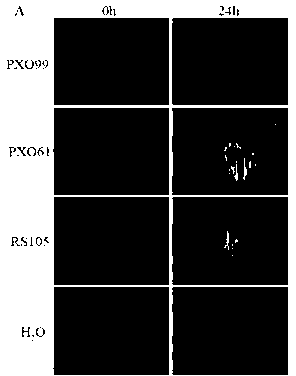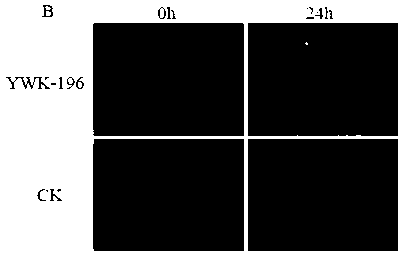Inducible promoter for pathogenic bacteria of rice
A technology of promoters and pathogenic bacteria, applied in the field of plant genetic engineering, can solve problems such as quality decline and yield reduction
- Summary
- Abstract
- Description
- Claims
- Application Information
AI Technical Summary
Problems solved by technology
Method used
Image
Examples
Embodiment 1
[0032] Example 1 Cloning and sequence analysis of rice 2H16 gene promoter p2H16
[0033] Primers were designed according to the upstream 2300bp sequence of rice Nipponbare 2H16 gene (GENBANK accession number: AK058338) (5ˊ-CAGACGGCTACTGTCCATCA-3ˊ, whose sequence is shown in SEQ ID NO.2; 5ˊ-GCGAGAGCAGGAGGAGAGAC-3ˊ, whose sequence is shown in SEQ ID NO.3 shown) was used to obtain the promoter of the gene.
[0034] Genomic DNA of rice IRBB13 was extracted and used as a template for PCR amplification. The reaction procedure was as follows: pre-deformation at 94°C for 5 min, denaturation at 94°C for 40 s, annealing at 54°C for 40 s, extension at 72°C for 2 min, reaction for 35 cycles, post-extension at 72°C for 7 min, After the end, the amplified fragment was recovered and purified with the DNA recovery kit of Kangwei Company, and then the purified DNA fragment was connected to the vector pGEM-T (Promega Company), incubated at room temperature for 1 hour, and transformed into E.col...
Embodiment 2
[0042] Example 2 Constructing the recombinant vector of 2H16 promoter sequence and GFP gene and transforming rice Zhonghua 11
[0043] Using rice IRBB13 DNA as a template, using a forward primer, its sequence is shown in SEQ ID NO.4 (5′-ATG GTC GAC CAGACGGCTACTGTCCATCA-3′, the underlined base is the restriction endonuclease SalI recognition site) and the reverse primer, its sequence is shown in SEQ ID NO.5 (5′-ATG CTGCAG .GCGAGAGCAGGAGGAGAGAC-3ˊ, the underlined base is the restriction endonuclease PstI recognition site) to amplify the promoter fragment, the PCR reaction procedure is as follows: pre-denaturation at 94°C for 5min, denaturation at 94°C for 40s, annealing at 62°C for 40s, extension at 72°C 2min, react for 35 cycles, and then extend at 72°C for 7min to obtain the -2197bp-+60bp region of the sequence SEQ ID NO.1, and add recognition sites for restriction endonucleases SalI and PstI at both ends of the sequence. After the reaction, the PCR product was detected by ...
Embodiment 3
[0045] Example 3 Detection of induced responses of p2H16 transgenic plants to pathogenic bacteria, salt and plant hormones
[0046] The transgenic seedlings of the T1 generation rice Zhonghua 11 grown in the greenhouse for about 3 weeks were subjected to various treatments. Xanthomonas PXO99, PXO61, the pathogen of bacterial blight of rice, RS105 of rice bacterial spot, YWK-196 of corn sheath blight, NaCl and three plant hormones of salicylic acid, gibberellic acid and abscisic acid were used respectively. Treat rice seedlings, and set untreated as control. The intensity of GFP activity before and after different treatments of different transgenic lines was detected. Among them, bacterial blight and thin streak bacteria were cultured on PSA medium at 28°C for 2 days, resuspended in sterile water, and inoculated by injection. One day after inoculation of pathogenic bacteria, the leaves of plants were taken for analysis; Cultivate on PDB medium at 25°C for 2 days, inoculate wi...
PUM
 Login to View More
Login to View More Abstract
Description
Claims
Application Information
 Login to View More
Login to View More - R&D
- Intellectual Property
- Life Sciences
- Materials
- Tech Scout
- Unparalleled Data Quality
- Higher Quality Content
- 60% Fewer Hallucinations
Browse by: Latest US Patents, China's latest patents, Technical Efficacy Thesaurus, Application Domain, Technology Topic, Popular Technical Reports.
© 2025 PatSnap. All rights reserved.Legal|Privacy policy|Modern Slavery Act Transparency Statement|Sitemap|About US| Contact US: help@patsnap.com



